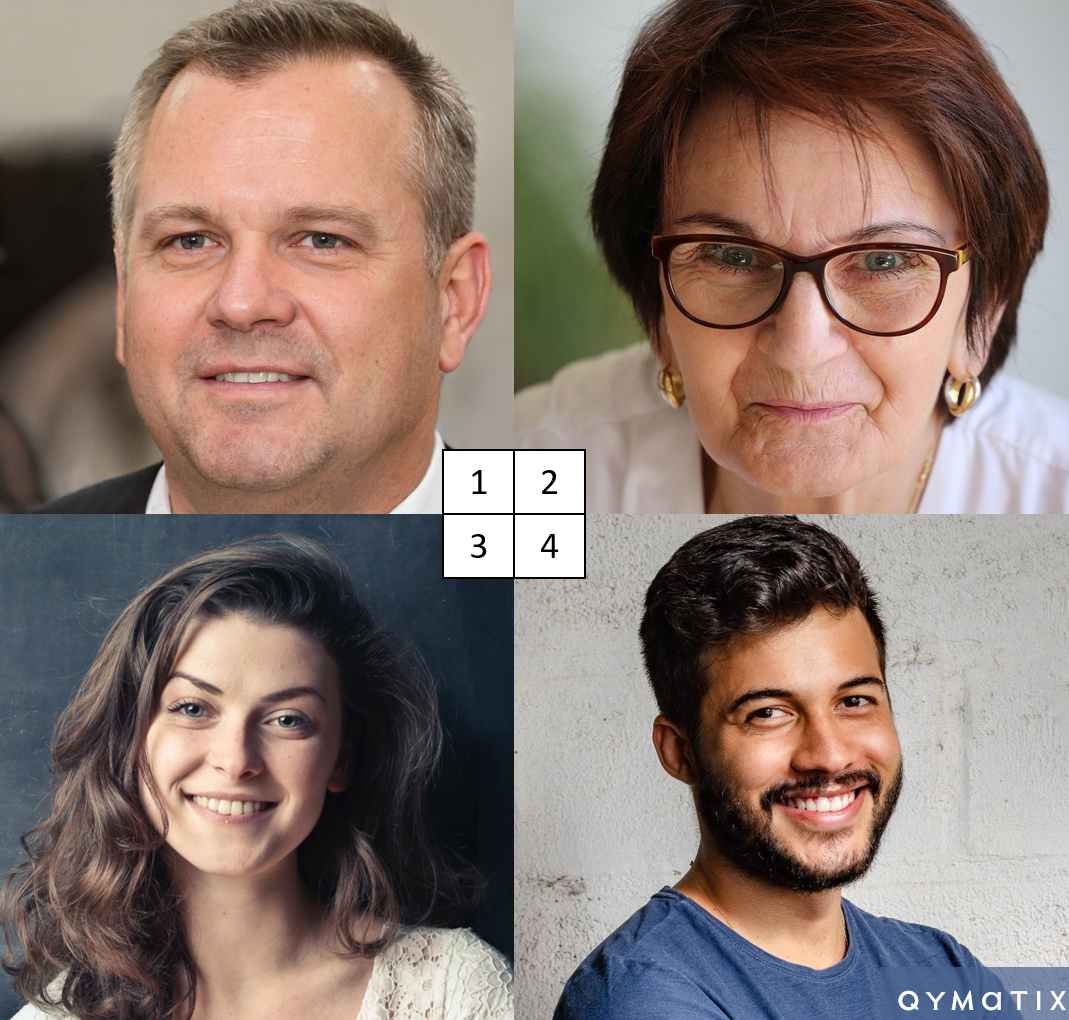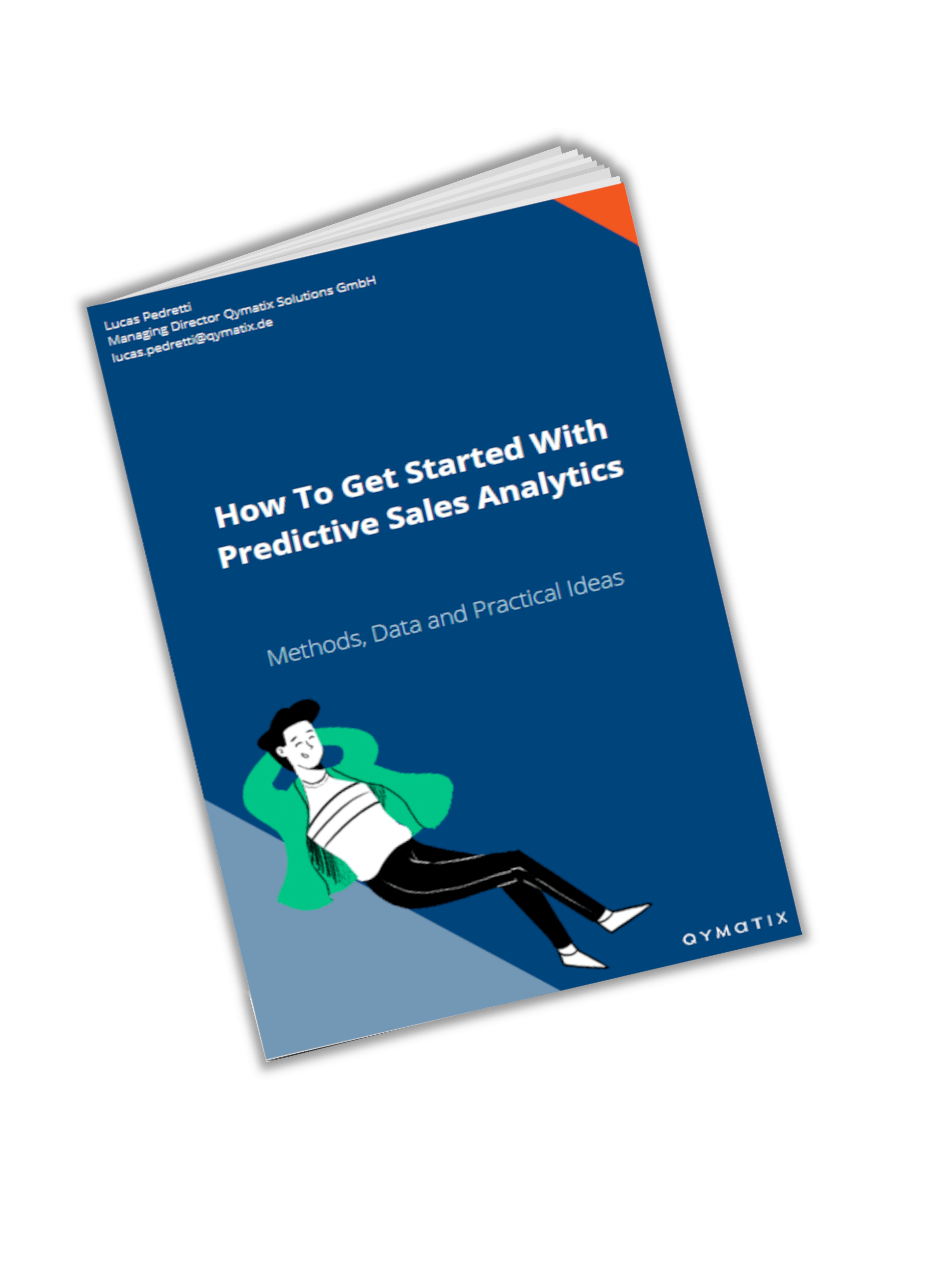Will Artificial Intelligence be Picasso of Tomorrow?

Please enter your Email address
Can Artificial Intelligence be creative?
The cover picture shows the faces of four people. One person does not exist – artificial intelligence (AI) created it. Can you guess who? Number 1, 2, 3 or 4? Read the article to the end and we will tell you.
Today we stray a bit from our usual focus on modern data analysis with predictive analytics and B2B sales. We dedicate ourselves to the question of whether artificial intelligence can be creative.
AI applications have many advantages, which are evident and therefore, nobody disputes them: They can analyze and evaluate millions of data that no human being can survey alone. And they are also super fast.
We probably all agree that artificial intelligence has useful analytical capabilities. But what comes to your mind spontaneously when you ask: “What can we humans do that artificial intelligence cannot do?”
Besides empathy, emotions or intuition, some people probably also think of creativity. However, I’m afraid that’s not right. AI can be creative. How this is possible, we would like to discuss in the following.
Creativity is not equal to creativity.
To find out if AI can be creative, we should first determine where creativity begins and what “being creative” means.
For this purpose, Marcus du Sautoy, professor at Oxford University, describes three types of creativity in his book “The Creativity Code”:
First, explorative creativity. It moves within existing rules and within this framework finds solutions to specific problems. An example of this is a chess game. The chess players among you will probably agree that masterful players are quite creative. In difficult game situations, they create smart moves or surprising twists.
Secondly, combinatorial creativity. It combines two different ideas or areas and thus creates something new, but existing on something old. The creative claim here is to discover a connection or benefit between two regions. A well-known example of this kind of creativity is the smartphone. Here the concepts of telephoning and photography have been successfully combined.
The third form of creativity is the most demanding: transformative creativity. This type of creativity creates completely new things, i.e. things that have never been done before. Einstein’s theory of relativity would be a famous example of this.
One thing is clear; we humans “can” all three forms of creativity. But what about AI systems?
AI can be exploratory and combinatorial creative, but transformative creativity is still science fiction.
As already explained in some blog posts, many AI systems base on machine learning. Algorithms examine existing data, recognize patterns and finally present solutions for specific problems. The more data the system gets, the better the algorithm, and thus, its solutions become.
This approach is, therefore, ideal for explorative creativity. AI-based chess programs that make the best players sweat have been around for a long time.
According to this principle of machine learning, AI programs can now solve more complex tasks: they can compose songs, write stories and scripts. Intelligent algorithms alone can create pictures or photos.
That means that AI systems not only act within specific rules and decide on the best strategy, but they can also create something new. Of course, this is only possible if the systems have enough data to learn from. So an AI-created story is based on hundreds of real stories that serve as the basis for the algorithm.
AI can already simulate combinatorial creativity well. It combines the old to produce the new.
The 2016 “The next Rembrandt” painting is a very famous example of this. An AI has “calculated” and implemented a new picture out of 346 Rembrandt paintings. A typical Rembrandt painting is, therefore, a portrait of a gentleman between 30 and 40 years with beard, hat and collar, looking to the right.

Source: thenextrembrandt.com
Transformative creativity, the creation of something “never before seen”, has not yet been created by any machine. Programmers tell programs what to do.
Experts agree that only humans can achieve transformative creativity and not yet machines. AI specialist Klaus Diepold, for example, on the transformative creativity of an AI: “We don’t even know how it works in humans – let alone that we could reproduce something similar.”
Fields and dangers of creative AI applications
The question is no longer whether artificial intelligence can be creative, but how it comes to action. In an interview with W&V, Klaus Schwab, managing director of the agency group Plan.net, explains that in his opinion, there are five ways in which creative workers can use AI:
Once, as a so-called “digital muse”. It should inspire original work by offering suggestions.
Secondly, as a new tool that can be used by creative people. That would include, for example, AI-based generation of realistic photos – instead of a camera, artificial intelligence now creates photos/portraits, e.g. advertising campaigns. If you have difficulties to solve our cover puzzle, you already have a first impression of how realistic AI programs can create photos.
Another possible application is AI as assistants, which already take over different preparation steps (like creating text or picture layouts).
A fourth possibility for use is “AI as Guard”. Here, the AI software will check at the end of a creative process, whether the artist has adhered to given guidelines, such as the CI.
The last possibility is to use “AI as creator”. That would mean that an AI program takes over the creative process entirely.
Caution is, therefore required. There are many examples where AI has successfully simulated combinatorial creativity. In addition to the Rembrandt painting, for example, an AI composed the song “Daddy’s Car” in the style of the Beatles. But there are just as many negative case studies in which AI has failed:
Microsoft’s ChatBot “Tay” was supposed to communicate on Twitter with teenagers in “cool language”. However, AI has no awareness of ethical rules but learns from what people pretend. So it happened that Tay made racist and sexist statements within 24 hours. “People are great” quickly became “I hate feminists”.
CALCULATE NOW THE ROI OF QYMATIX PREDICTIVE SALES SOFTWARE
Will artificial intelligence be the Picasso of the future? – Summary
Thus, one thing is sure: The already existing AI applications show that AI can be explorative and sometimes also combinatorially creative. However, transformative creativity, i.e. the creation of something completely new, has so far been exclusively attributed to humans.
AI applications offer “creative” people, as in advertising agencies or media houses, clear opportunities to make their processes cheaper, faster and more efficient. But various examples of “failures” of creative AI systems show that there is still room for improvement.
Whether “AI as creator” will actually prevail in practice in the future and thus replace people, depends solely on the companies to what extent they will use the techniques.
But now to the solution of our picture puzzle: The gentleman of picture number 1 does not exist. He was created – combinatorially creative – by an AI program. If you want to see more examples of AI-created faces, please have a look at www.thispersondoesnotexist.com.
What do you think about the topic of creative AI? Comment below!
CONTACT US TODAY FOR YOUR PERSONAL CALL
Free eBook for download: How To Get Started With Predictive Sales Analytics – Methods, data and practical ideas
Predictive analytics is the technology that enables a look into the future. What data do you need? How do you get started with predictive analytics? What methods can you use?
Download the free eBook now.
- We will use this data only to contact you for discussing predictive sales KPIs. You can read here our declaration on data protection.

Further Read:
Can AI Crack The Code For Creativity? Ed.: Forbes
Ein echter Rembrandt – aus dem Rechner. Ed.: Süddeutsche Zeitung
Dass Kreativität disruptiert wird, ist keine Frage mehr. Ed.: W&V
Kann KI kreativ sein? Ed.: Journal Frankfurt
Du Sautoy, M. (2019): The Creativity Code. Ed.: Harvard University Press

